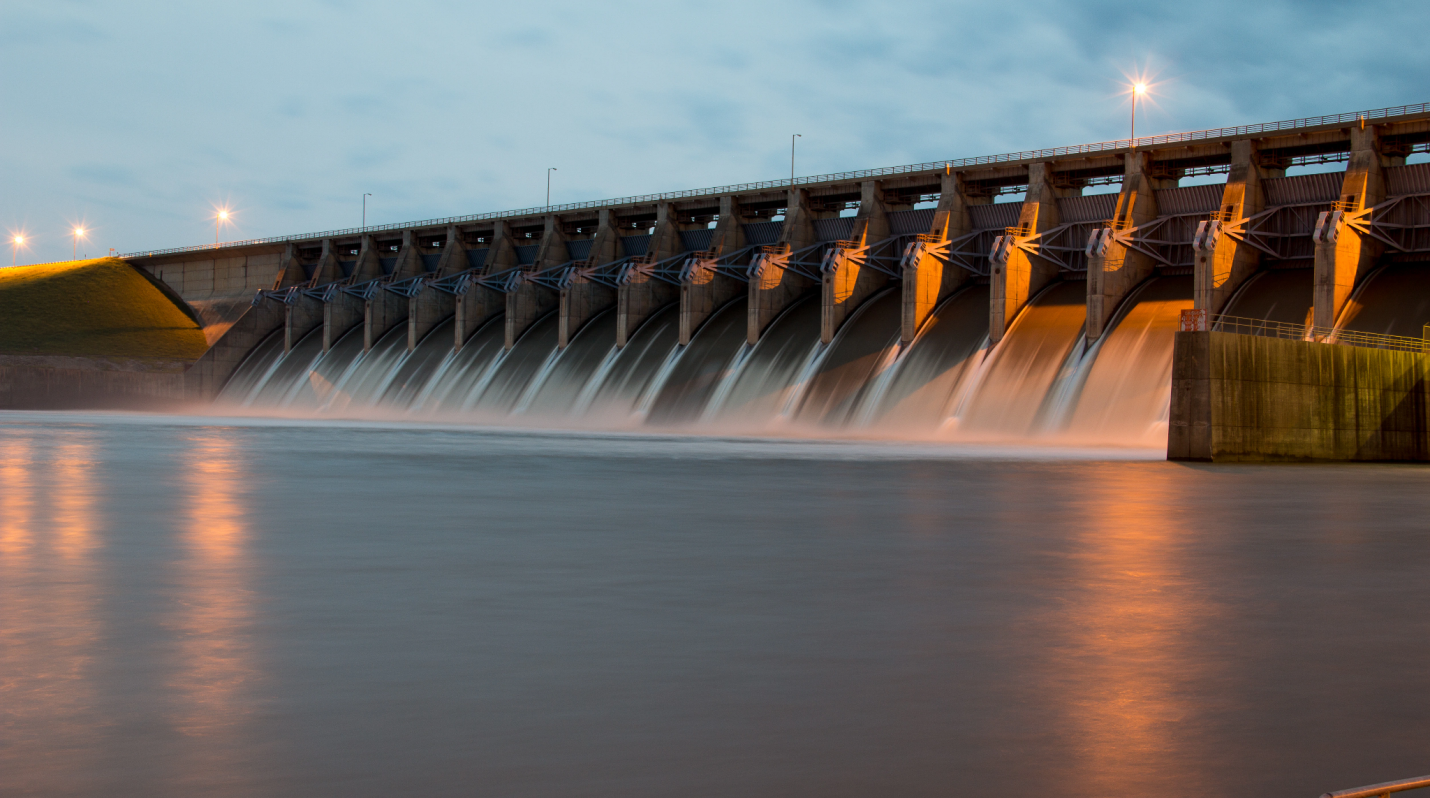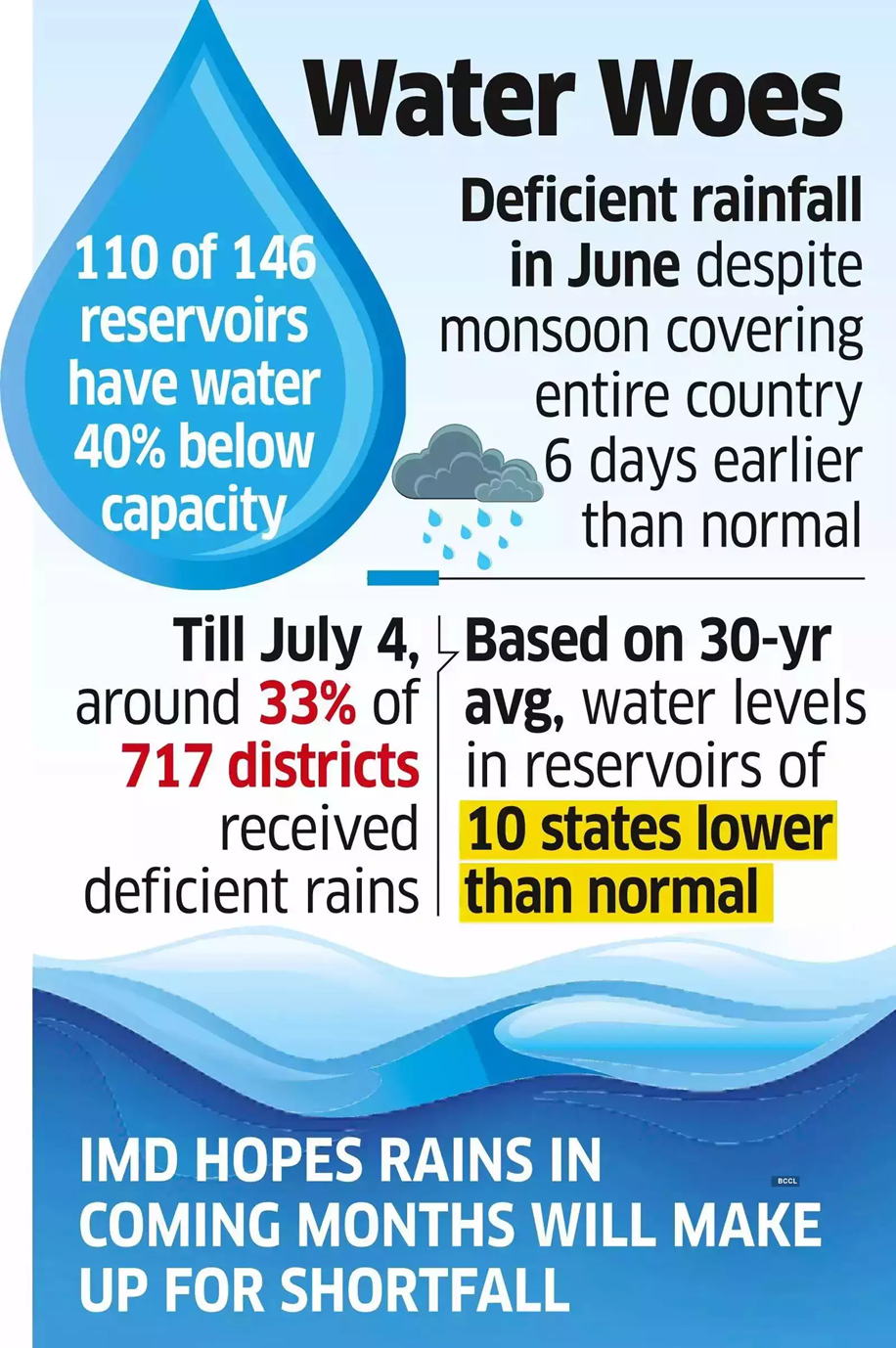Description

Copyright infringement not intended
Context: India is facing a serious water crisis as most of its reservoirs are running low on water due to deficient rainfall in June, the first month of the monsoon season. This has affected the sowing of kharif crops and raised concerns about the availability of water for irrigation and drinking purposes till May 2024.
Details
- According to the latest data from the Central Water Commission (CWC), which monitors 146 reservoirs across the country, water levels in 110 of them are 40% or below their capacities as on June 30.
- The CWC data also shows that water levels in the reservoirs of 10 states are lower than the normal levels based on their 30-year average. These states are Bihar, West Bengal, Odisha, Jharkhand, Uttar Pradesh, Uttarakhand, Kerala, Karnataka, Tripura and Nagaland. The deficiency ranges from 11% to 80% in these states.
- The situation is alarming as India's hydrological year starts in June and continues till May of next year. The reservoirs depend on the monsoon rains for filling up during the June-September period. However, this year, several parts of India received deficient rainfall in June, despite the monsoon covering the entire country six days earlier than normal, said experts.
- The India Meteorological Department (IMD) data reveals that till July 4, around 33% of 717 districts for which data are available received deficient rains, while for another 10%, it was even worse.
- Insufficient rainfall has also affected the sowing of main kharif crops such as paddy, which requires adequate water for germination and growth.
- The CWC, however, said that the water level was better than the last 10-year average and that it reviews the situation on a weekly basis along with other departments under the Ministry of Agriculture & Farmers' Welfare to take further actions.

Central Water Commission (CWC)
- The Central Water Commission (CWC) is a premier technical organization in India in the field of water resources. It was established in 1945 as an advisory body to the Government of India on matters relating to water resources development and management.
- It operates as an attached office of the Ministry of Jal Shakti, Department of Water Resources, River Development and Ganga Rejuvenation, Government of India.
- Its main role is to plan, design and implement schemes for the management, conservation and use of water resources across the country, for purposes such as flood control, irrigation, navigation, drinking water supply and hydropower generation.
Working Structure
- CWC is headed by a Chairman, who has the rank of Ex-Officio Secretary to the Government of India. The work of CWC is divided into three wings:
- Designs and Research (D&R) Wing
- River Management (RM) Wing
- Water Planning and Projects (WP&P) Wing.
- Each wing is led by a Member, who has the rank of Ex-Officio Additional Secretary to the Government of India and oversees several organizations that perform specific tasks and duties within their scope of functions.
- A separate Human Resources Management Unit (HRMU) headed by a Chief Engineer, handles the human resources development, financial management, training and administrative matters of CWC.
- National Water Academy (NWA) located in Pune is responsible for training central and state in-service engineers and it functions directly under the guidance of the Chairman.
- CWC has nineteen organizations located at its headquarters in New Delhi and thirteen organizations spread over various locations in India.
The main functions of the CWC are:
- To provide technical assistance and guidance to the state governments and central ministries on planning, design, construction, operation and maintenance of water resources projects.
- To undertake a techno-economic appraisal of major and medium irrigation, flood control and multipurpose projects and to accord investment clearance.
- To monitor the implementation of major and medium irrigation, flood control and multipurpose projects and to evaluate their performance.
- To collect, compile and publish hydrological and hydro-meteorological data and to maintain a national network of observation stations.
- To carry out surveys and investigations for basin planning, inter-state water disputes, flood forecasting and reservoir regulation.
- To conduct research and studies on various aspects of water resources engineering, hydrology, sedimentation, soil conservation, groundwater, etc.
- To promote international cooperation in water resources development and management.
The CWC plays a vital role in the optimal utilization and management of the country's water resources. It contributes to the national objectives of enhancing food security, ensuring water security, mitigating floods and droughts, promoting regional equity, fostering interstate harmony and safeguarding environmental sustainability.

Some of the major achievements of the CWC are:
- Preparation of National Perspective Plan for Water Resources Development (NPP) envisaging interlinking of rivers for optimal utilization of surplus water.
- Development of National Water Policy (NWP) providing a framework for water resources planning, allocation and management at various levels.
- Formulation of the National Hydrology Project (NHP) for strengthening the hydrological information system and improving the quality and reliability of data.
- Establishment of the National Water Informatics Centre (NWIC) for creating a comprehensive web-based water resources information system.
- Implementation of a Dam Rehabilitation and Improvement Project (DRIP) for improving the safety and operational efficiency of existing dams.
- Coordination of Jal Shakti Abhiyan (JSA) for enhancing water conservation and recharge activities across the country.
Challenges
- Increasing demand-supply gap due to population growth, urbanization, industrialization, climate change, etc.
- Declining per capita availability and quality of water due to over-exploitation, pollution, degradation, etc.
- Rising conflicts and disputes over sharing of water among states, sectors and users.
- Inadequate institutional capacity and financial resources for planning, implementation and maintenance of water resources projects.
- Lack of public participation and awareness on water conservation and management issues.
To overcome these challenges, the CWC needs to adopt a holistic, integrated and participatory approach towards water resources development and management.
Some of the possible ways forward are:
- Strengthening the data collection, analysis and dissemination system for informed decision-making.
- Promoting conjunctive use of surface and groundwater to augment water availability and reduce stress on aquifers.
- Encouraging demand management measures such as water pricing, metering, rationing, etc. to reduce wastage and improve efficiency.
- Enhancing inter-sectoral coordination and cooperation for optimal allocation and utilization of water among competing uses.
- Resolving inter-state water disputes through dialogue, negotiation and arbitration mechanisms.
- Implementing participatory irrigation management (PIM) involving farmers' organizations in the operation and maintenance of irrigation systems.
- Adopting best practices in the design, construction, operation and maintenance of dams to ensure their safety and performance.
- Incorporating environmental and social aspects in water resources planning, appraisal and implementation to minimize adverse impacts.
- Creating awareness among stakeholders on the importance of water conservation and management through mass media, education, training, etc.
Conclusion
- The Central Water Commission is a key institution in the field of water resources development and management in India. It has a rich legacy of achievements as well as a huge responsibility for the future. It needs to constantly innovate, adapt and evolve to meet the emerging challenges and opportunities in the sector. By doing so, it can play a pivotal role in ensuring water security for the nation.
Must-Read Articles:
MIHIR SHAH COMMITTEE REPORT: https://www.iasgyan.in/daily-current-affairs/mihir-shah-committee-report
|
PRACTICE QUESTION
Q. What is the main function of the Central Water Commission?
1. To regulate and develop inter-state rivers and river valleys.
2. To monitor and forecast floods and droughts.
3. To advise the government on water resources planning and management.
How many of the above statements is/are correct?
A) Only 1
B) Only 2
C) All of the Above
D) None of the Above
Answer: C
Explanation: The Central Water Commission is a premier technical organization under the Ministry of Jal Shakti, Government of India, that performs various functions related to water resources development and management in India.
|

https://economictimes.indiatimes.com/news/india/water-levels-at-less-than-half-in-75-of-reservoirs-cwc-data/articleshow/101495961.cms











